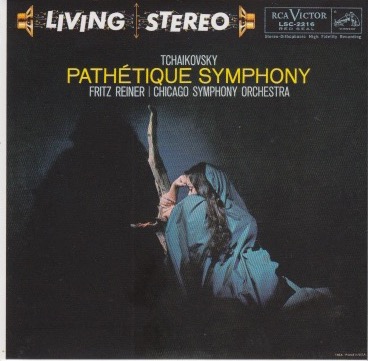
Great. Just what I needed when I already had a case of the Mondays (on a Tuesday, no less): a “solemn” or “emotive” symphony.
What I really need to get my peepers to stay open is Grand Funk Railroad’s We’re An American Band, or Frank Zappa’s Roxy & Elsewhere, or Dream Theater’s Images and Words album, or even Frank Sinatra’s [fill in the blank, they’re all classics].
Instead, I get Pyotr Ilyich Tchaikovsky’s (mis)translated Pathétique Symphony.
To make matters worse, I forget to pack my headphones. So I’m listening to today’s music with my earbuds jammed into (where else?) my ears.
I got through the first movement (Adagio, Allegro Non Troppo) and smiled – for, near the end of its 18:11 length, good ol’ Pyotr added one of my favorite symphonic devices: pizzicato, the sound old-timey cartoon characters make when they’re sneaking up on one another. For some reason, that tip-toe sound makes me happy.
Say, maybe the musical selection for this rain-soaked Tuesday morning (the day after America’s 4th of July celebration) won’t be so bad after all.
Wait. About 5:40 into the schmaltz of Movement II (Allegro Con Grazia), my old friend pizzicato returns to uplift me. (Which is a really good thing because the music this particular bagel restaurant is playing today is so god-awful irritating that it makes even Tchaikovsky appealing to me.)

As is my wont, whenever I encounter a term I don’t recognize, I look it up. In this case, it’s “Allegro Con Grazia.” The word I’m unfamiliar with is “grazia.” I suspect I know what the word means. But I don’t know for sure. So…
According to the Almighty Internet, “Allegro Con Grazia” means “briskly, with grace, or gracefully.”
Mystery solved.
The third movement (Allegro Molto Vivace – “fast, very lively”) sounds like a movie score to me. Sort of like something Erich Wolfgang Korngold might have composed for The Adventures of Robin Hood (the Errol Flynn classic). Or John Williams might have composed for Raiders of the Lost Ark. It’s triumphant, expressive, and – yes -very lively, all right. I could tell it was lively by the crash of cymbals every so often. (I wonder if Korngold or WIlliams were fans of Tchaikovsky. This movement sounds so much like a movie soundtrack that I’d be gobsmacked if they weren’t.)
The final movement (“Adagio Lamentoso, Andante”) is definitely making me lament. But, wait…
The Objective Stuff
From its entry on Wikipedia,
The Symphony No. 6 in B minor, Op. 74, also known as the Pathétique Symphony, is Pyotr Ilyich Tchaikovsky’s (1840-1893) final completed symphony, written between February and the end of August 1893. The composer entitled the work “The Passionate Symphony”, employing a Russian word, Патетическая (Pateticheskaya), meaning “passionate” or “emotional”, which was then (mis-)translated into French as pathétique, meaning “solemn” or “emotive”.
The composer led the first performance in Saint Petersburg on 28 October [O.S. 16 October] of that year, nine days before his death. The second performance, conducted by Eduard Nápravník, took place 21 days later, at a memorial concert on 18 November [O.S. 6 November]. It included some minor corrections that Tchaikovsky had made after the premiere, and was thus the first performance of the work in the exact form in which it is known today. The first performance in Moscow was on 16 December [O.S. 4 December], conducted by Vasily Safonov. It was the last of Tchaikovsky’s compositions premiered in his lifetime; his last composition of all, the single-movement 3rd Piano Concerto, Op. 75, which was completed in October 1893, a short time before his death, received a posthumous premiere.
Given that, we can conclude that Tchaikovsky was 53 when he finished this piece of music. It was recorded over two days (April 16 and April 17) in 1957, at Chicago Hall. Fritz Reiner was 69 when he conducted it.
The Subjective Stuff
Recording quality: 4 (a little tape hiss evident)
Overall musicianship: 5
CD booklet notes: 2
CD “album cover” information: 4.5 (lots and lots of really tiny print)
How does this make me feel: 4
For a piece by Tchaikovsky, a rating of 4 is quite good. At least, for me.
One thing I noticed is that the symphony (the aforementioned “lament”) ends the same way The Beatles’ unforgettable song “A Day In the Life” does: With a sonorous, sustained note/chord that fades into silence. In the Beatles’ song, it occurs at the 4:21 mark when all four musicians, well…I’ll turn to its entry on Wikipedia,
Following the final orchestral crescendo, the song ends with one of the most famous final chords in music history. Overdubbed in place of the vocal experiment from 10 February, this chord was added during a session at EMI’s Studio Two on 22 February. Lennon, McCartney, Starr and Evans shared three different pianos, with Martin on a harmonium, and all played an E-major chord simultaneously. The chord was made to ring out for over forty seconds by increasing the recording sound level as the vibration faded out. Towards the end of the chord the recording level was so high that listeners can hear the sounds of the studio, including rustling papers and a squeaking chair. In author Jonathan Gould’s commentary on “A Day in the Life”, he describes the final chord as “a forty-second meditation on finality that leaves each member of the audience listening with a new kind of attention and awareness to the sound of nothing at all”.
One of the first outsiders to hear the completed recording was the Byrds’ David Crosby when he visited the Beatles during their 24 February overdubbing session for “Lovely Rita“. He recalled his reaction to the song: “Man, I was a dish-rag. I was floored. It took me several minutes to be able to talk after that.” Due to the multiple takes required to perfect the orchestral cacophony and the final chord, the total time spent recording “A Day in the Life” was 34 hours. By contrast, the Beatles’ debut album, Please Please Me, had been recorded in its entirety in only 15 hours, 45 minutes.
That’s what the end of Tchaikovsky’s Pathétique Symphony reminded me of.
The fourth movement ends with a sustained drone, reminiscent of the final chord in “Life,” that lasts for about :30 (roughly 10:15 to the end at 10:42) as it fades into silence.
That can’t be a coincidence, can it? Two compositions – “A Day in the Life” and Pathétique Symphony – that are kind of the musical expression of life, both ending on a sustained, somber note for about :30 seconds?
I Googled “The Beatles and Tchaikovsky” and didn’t find anything. However, I did discover that the decaying chords to both “A Day in the Life” and Pathétique Symphony have a name, as does the entire mood of the Sixth Symphony.
According to its entry on WIkipedia,
Tchaikovsky critic Richard Taruskin writes:
Suicide theories were much stimulated by the Sixth Symphony, which was first performed under the composer’s baton only nine days before his demise, with its lugubrious finale (ending morendo, ‘dying away’), its brief but conspicuous allusion to the Orthodox requiem liturgy in the first movement and above all its easily misread subtitle. … When the symphony was done again a couple of weeks later, in memoriam and with subtitle in place, everyone listened hard for portents, and that is how the symphony became a transparent suicide note. Depression was the first diagnosis. ‘Homosexual tragedy’ came later.
Yet critic David Brown describes the idea of the Sixth Symphony as some sort of suicide note as “patent nonsense”.
The “morendo” is what ties together The Beatles “A Day in the Life” and Pathétique Symphony.
Interesting.
I was more intrigued by Tchaikovsky’s Pathétique Symphony than I probably should have been – probably because of all of the interesting things I learned about it.
But I thought this was a well-recorded, compelling performance that I could envision myself listening to again.
